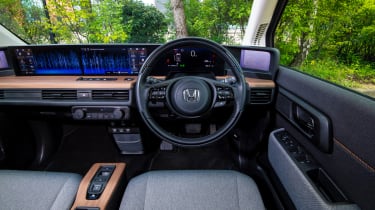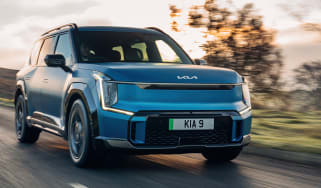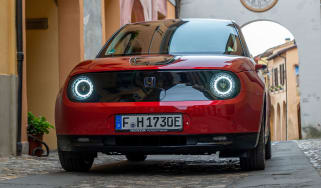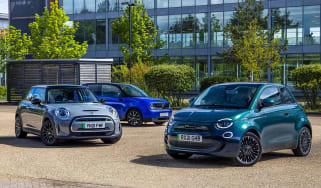Honda e review
The Honda e features cool retro design and futuristic technology, but less stylish rivals beat it in the less glamorous but more useful areas of range and practicality
Pros
- Great to drive
- Packed with equipment
- Striking looks inside and out
Cons
- Expensive
- Short range
- Limited practicality
| Car type | Range | Wallbox charge time | Rapid charge time |
|---|---|---|---|
| Electric | 131-137 miles | 5hrs 15mins (0-100%, 7.4kW) | 36mins (10-80%, 100kW) |
Honda e verdict
The Honda e is a tiny city car with a big problem. We love its retro styling inside and out, while the trio of screens in the interior generate a wow-factor that even more luxurious models cannot quite match. It’s fun to drive too, and although the Honda e’s boot is pretty compact, so are those of its rivals. The real thing that holds Honda’s tiny hatchback from greatness, however – other than its incredibly short range – is its ridiculously high base price which stands at over £10,000 more than the equivalent Fiat 500 or BYD Dolphin. Hefty depreciation means there’s plenty of deals to be found on the used market, though.
Range details, specs and alternatives
Apart from the Civic Type R hot hatch, every model in Honda’s line-up is now electrified in some way. However, the Japanese maker only offers two models with fully-electric power: the confusingly-named Honda e:Ny1, and the Honda e supermini.
The retro-inspired styling of the Honda e was an instant hit when it first appeared as a motor show concept – and the production version that arrived in 2020 brought all that headline grabbing style into dealerships. Honda’s designers have cleverly worked the pleasing old-school charm of 1970s hatchbacks into a modern package – and the result is hard to resist.
The Honda e has potential rivals of various shapes and sizes, but its key competition comes from the similarly retro-inspired Fiat 500, MINI Electric and Ora Funky Cat – the latter being our Best Urban Electric Car for 2023. Other slightly less fashion-conscious hatchbacks the e’s rivals include the Peugeot e-208, Vauxhall Corsa Electric, Renault ZOE, plus the £25k BYD Dolphin
Speaking of pricing, the Honda e is significantly more expensive than all of its competitors. In fact, with a starting price of around £37,000 at the time of writing, it’s more expensive than an entry-level Cupra Born or Hyundai Kona Electric, as well as the Kia Niro EV, which are all larger and offer about double the range of the Honda. The Honda e wasn’t always this pricey, though. When we first tested the e it had a starting price of around £27,000, but at that time the car was eligible for the government's plug-in car grant, which has since been axed.
For a time there were also three trim levels to choose from: a base model, the Honda e Advance and finally a Honda e Limited Edition. As of August 2023, however, you can only order the higher-spec Advance model. Its single electric motor produces 152bhp, compared to 134bhp in the base model, while range from the 35.5kWh battery stands at 131 miles.
At least for the money the Honda e Advance gets a generous amount of standard kit, including heated seats and steering wheel, adaptive cruise control, blind-spot monitoring, a rear-view camera display built into the rear-view mirror, automatic parking, LED headlights and 16-inch alloys.
Click here to see why you can trust DrivingElectric reviews, or for a more detailed look at the Honda e, read on for the rest of our in-depth review...






